Recap:
For those of you that didn’t read the first review, here is a general recap. The Sig Tango6T is a quality LPVO with great eye relief, it is IPX7 waterproof, and it is an FFP scope with a BDC reticle that can take you out to 800 yards. I was impressed with the fit and finish, as well as Sig’s “Infinite Lifetime guarantee”. Should you somehow break your scope, Sig has you covered! I’m not going to bore you with all the details from part one, (read it here) but this scope is packed with features. So for part two, we are going to evaluate the Tango6T in use. Without further ado:
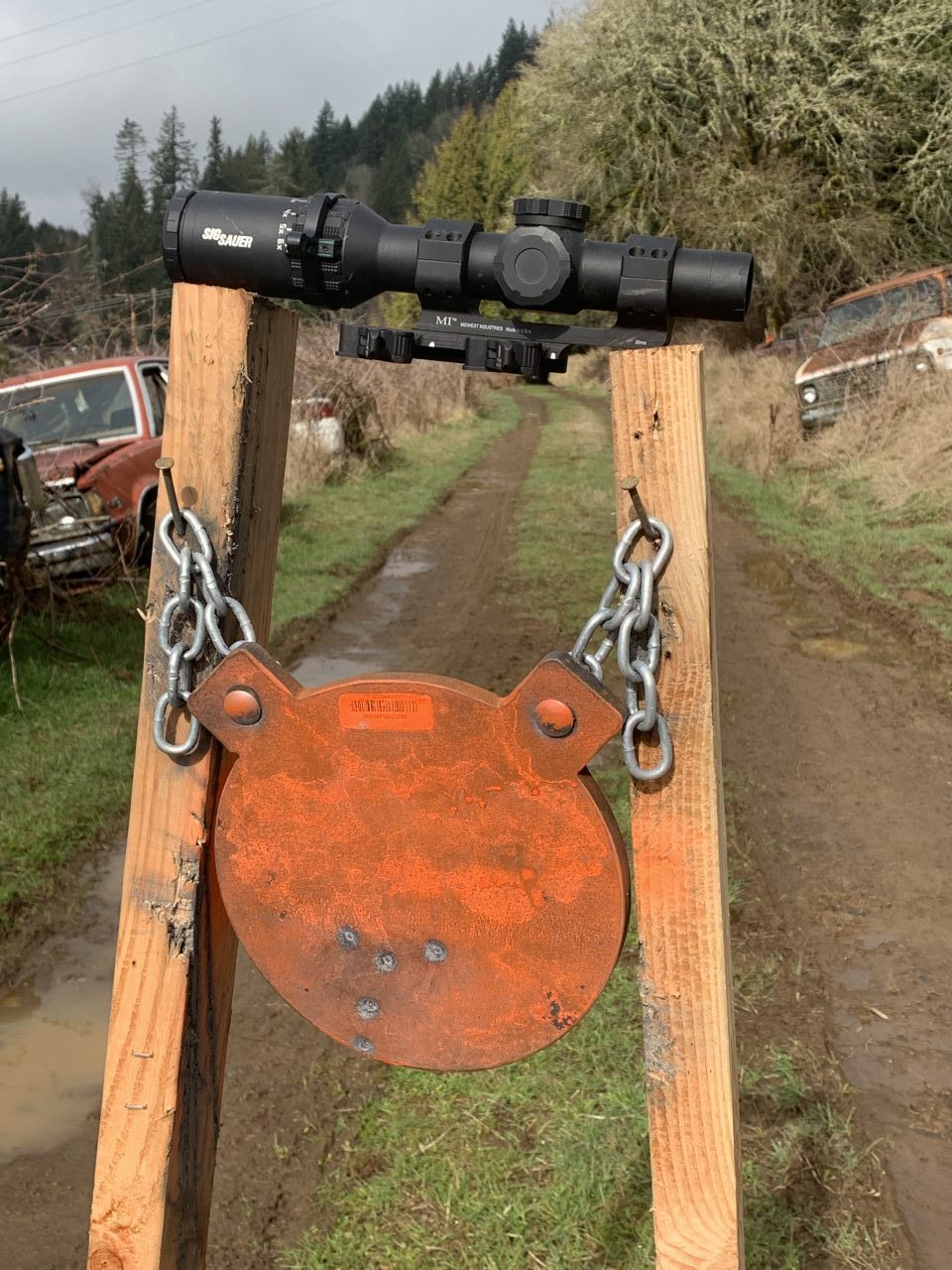
Tango6T during the Midwest Industries Mount testing
The Reticle:
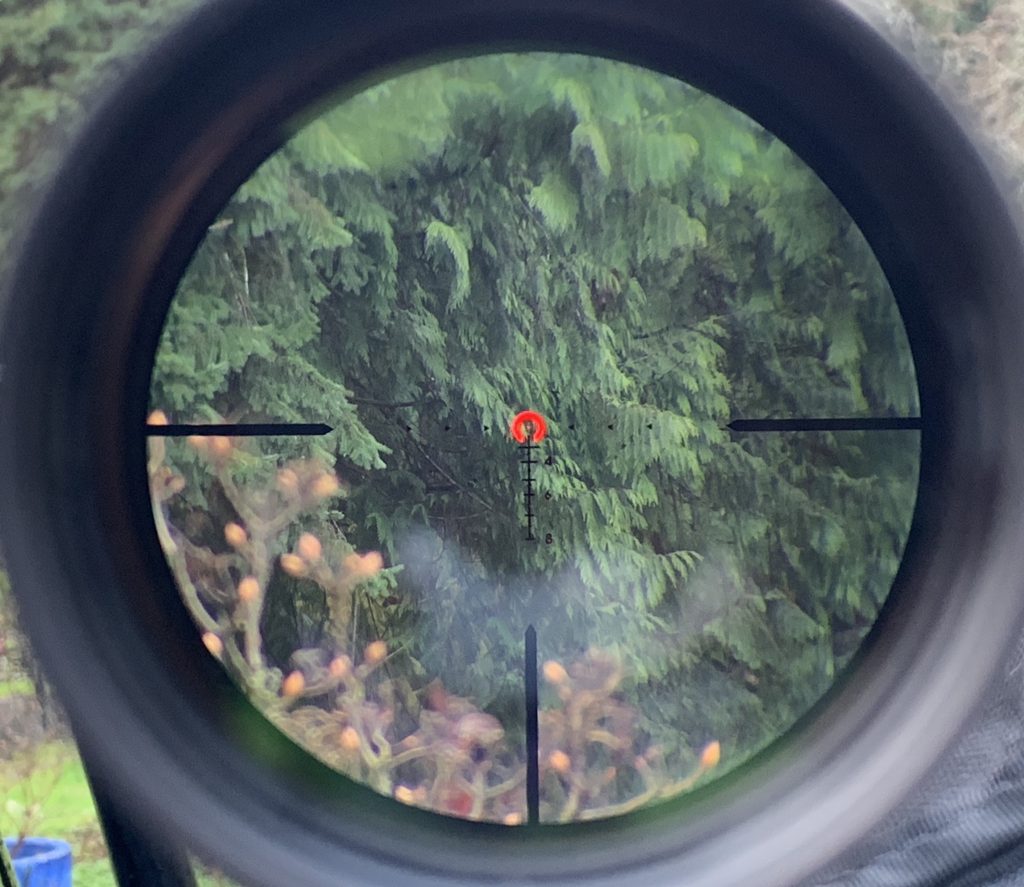
At 1x the optic aims to be a red dot, and as you increase magnification the reticle grows in size to reveal the BDC component.
I feel the 556/762 Horseshoe Dot reticle in the Tango6T is everything you need and nothing you don’t. It’s a very simple reticle, doesn’t obstruct your field of view, and at 1x it naturally draws the eye to the center dot. I have found the reticle to be very easy to use at any distance. Being a First Focal Plane optic the optic is very fast up close and for me, it posted times similar to a red dot in the drills I run. I will say however that I was a little more accurate with my red dot because I could see the red dot easier. One of my two complaints is that the optic is daylight visible, but not daylight bright. I could see my red dot very easily whereas I was using the cross-hairs as my aiming point to shoot with the Tango6T. The red dot provided me a more precise point, the difference in group sizing was a closed fist vs an open hand at 7 yards. My other gripe is that the reticle doesn’t have wind holds other than the two horizontal crosshairs. You can use those to kind of eyeball your wind holds at different distances. Not as accurate as the actual wind holds at the different distance holds. A 5 or 10 mph wind hold would have been great ala the ACSS system.
I also truly appreciate the fact that when this reticle is illuminated, only the horseshoe and dot are illuminated. Once you crank the brightness up to 9 and it’s dark out, you will notice the outline of the rest of the reticle is red around it a little bit, but that’s only in a very specific condition that you notice it. The rest of the time that you’re using this scope, it’s just the horseshoe dot and that is very easy to use. I hate optics that illuminate the whole reticle. That is a huge win for me in my book, thank you Sig!
On 1x magnification, this scope is very close to a red dot. For me, most of my shooting was in the PNW during the winter, which doesn’t offer the brightest conditions to shoot in. I did, however, get extremely lucky and one of the last times I went shooting and got a beautiful clear blue sky and bright day. What I found was that the reticle is daylight visible, but not daylight bright… However, having the bold crosshairs on 1 power gives you the ability to find the reticle faster even though it’s not as bright as an RDS. (See Why the German #4 Still Rocks!) So for me, while doing up drills, double taps, and failure drills, I was about one-tenth of a second slower with this scope on my rifle than I was with my red dot on my AR pistol. And I fully attribute that to my rifle just being heavy. I give it a full pound and a half over my pistol.
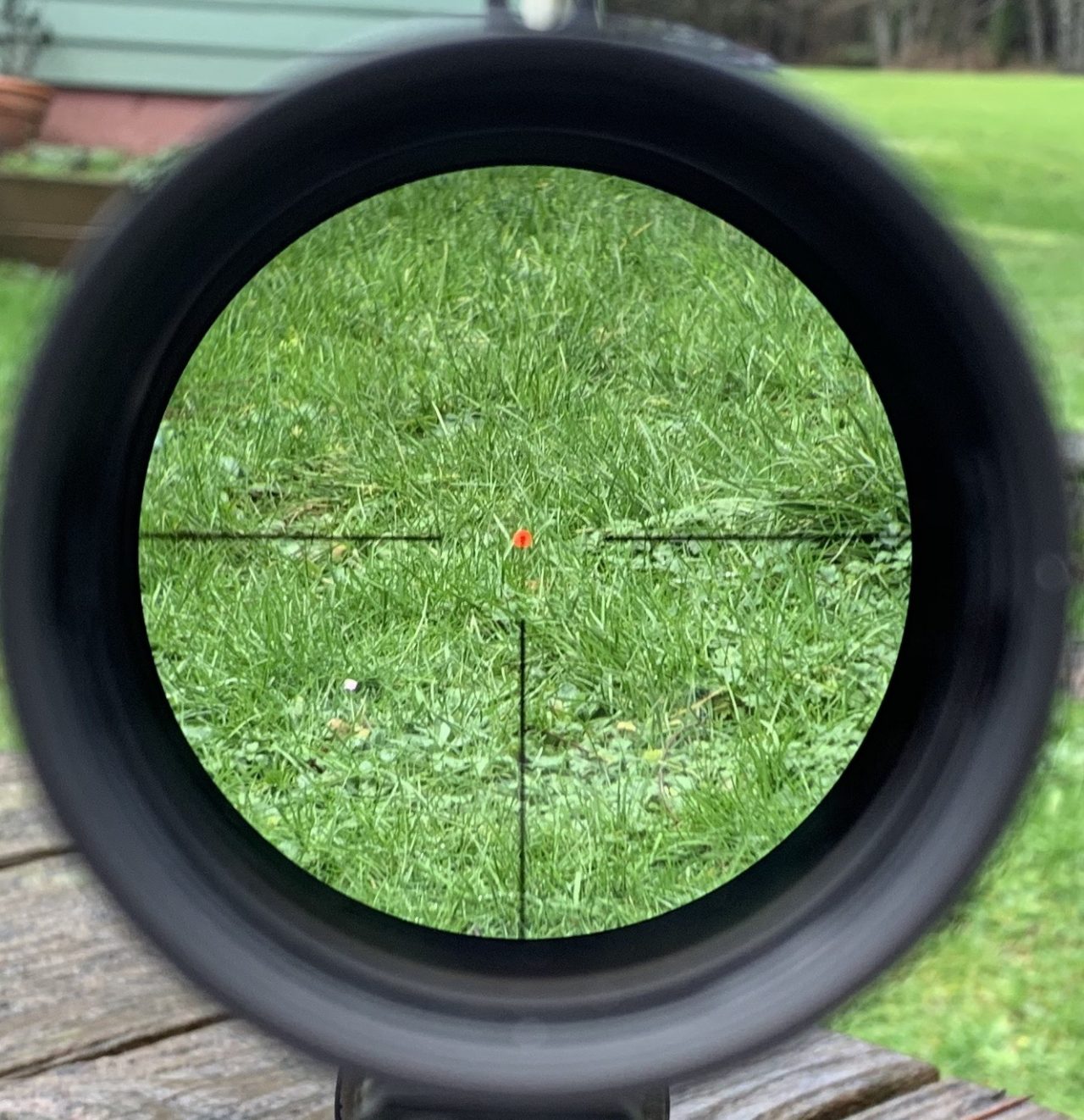
The bold crosshairs draw your eye to the reticle. The reticle is nice and bright on overcast days in the Pacific Northwest but is not red-dot bright.
Turrets and Tracking:
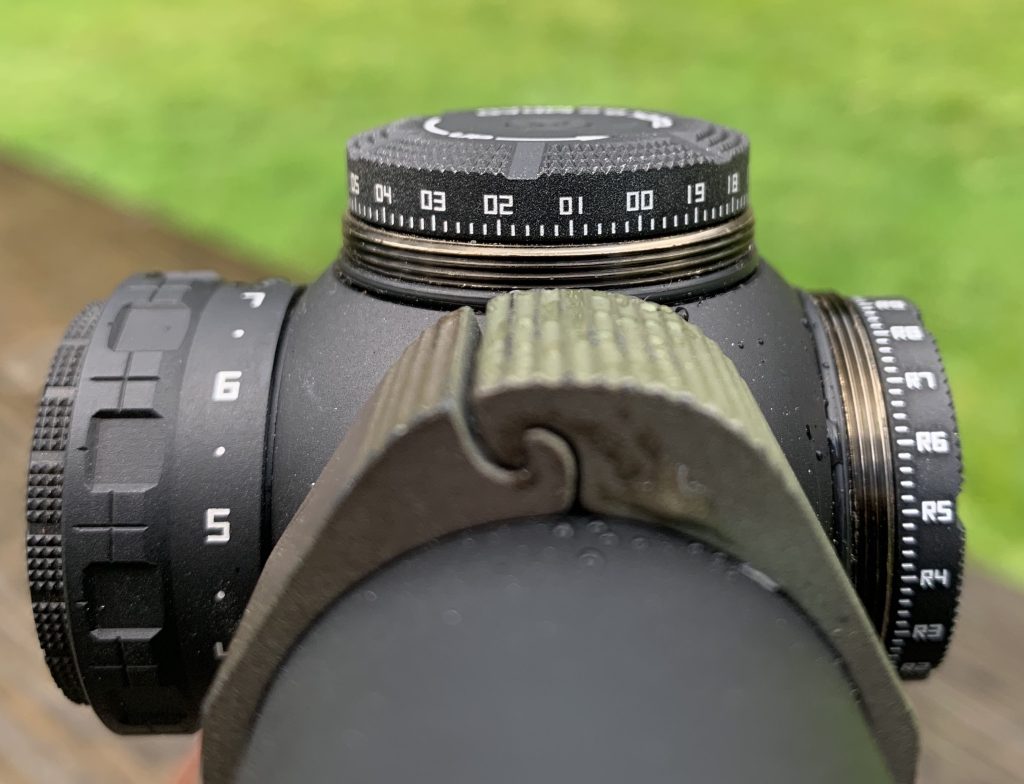
.2 mrad click turrets and an off position between each illumination setting
The turrets on this scope are very user friendly! They are precisely marked so its easy to find your adjustments. You will notice that while making your adjustments, the clicks are very tactile and audible, you know when you have moved your turret. While they are easy to move, they aren’t loose… they’re smooth. I have used scopes where their turrets are very hard to rotate, extremely mushy, and I couldn’t tell if I adjusted without taking my ear pro off and removing my glove. With the Sig’s turrets being so smooth, easily tracked, and having a return to zero feature, I would have no problem using the turrets to dial into my target if I felt like it.
I couldn’t have picked a more perfect day for the turret tracking test. It was a beautiful 60 degree, PNW bright blue sky with no wind day… And then the local Sportsman’s had to screw me over because, for the last couple of days, they haven’t had any 5.56 Hornady Frontier M193 ammo that I zeroed the scope with. (editor: everyone is gonna shoot the Coronavirus. Welcome to Merica). So the results aren’t as “perfect” as I would like because of the different ammo I had to use. Either way though, the results were great and the scope tracks extremely well! I adjusted for 1 Mil left and right, as well as 1 and 2 mils up and down. And after all the adjustments, it came right back to the center. So I cannot complain. The turrets track reliably, they track extremely smoothly with very audible and tactile clicks to let you know that you adjusted your turret.
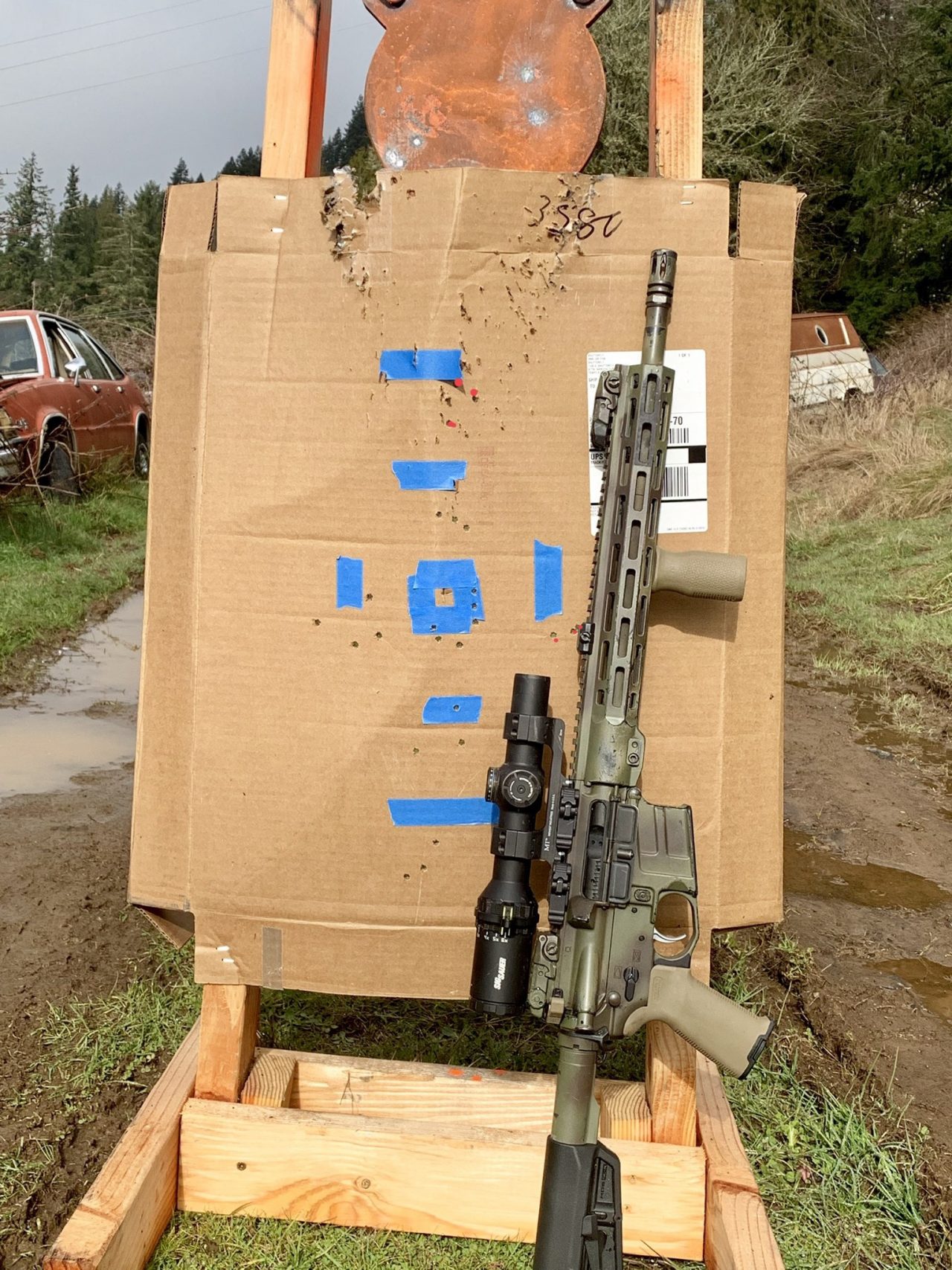
Tango6T tracking test
I made the mistake of shooting my steel target before taking the picture. Sorry guys.
With all of that for just the turrets, Tango6T gets a 10/10 in my opinion for the turrets
Durability:
One of the biggest questions buyers have for an LPVO is how durable is it? If I am going to be using a 1-6 scope for a multitude of things, it needs to be able to withstand bumps and drops and anything that may happen to it. Throughout my time using this scope, I haven’t gone easy on it. It has been dropped, slammed, beaten, tossed around and bounced around the truck bed with other guns and didn’t miss a beat.
I also need to mention that I am not used to such nice equipment and am so thankful for the opportunity from Sig to review this scope, with that being said, one of the hardest things for me to do as a reviewer, is beat my gear or “torture test” it. I am not into destroying gear, but rather simulating what kind of real-life things could happen, and do it a lot. I have no problem dropping a rifle from shoulder height, giving it a good toss, bumping it on a tree or things like that. You won’t find me dragging my rifles behind a car, throwing them as far as I can, or using them like a hammer. So sorry if that’s what you’re looking for in a durability test, but in my mind, that’s not realistic for the everyday average gun owner.
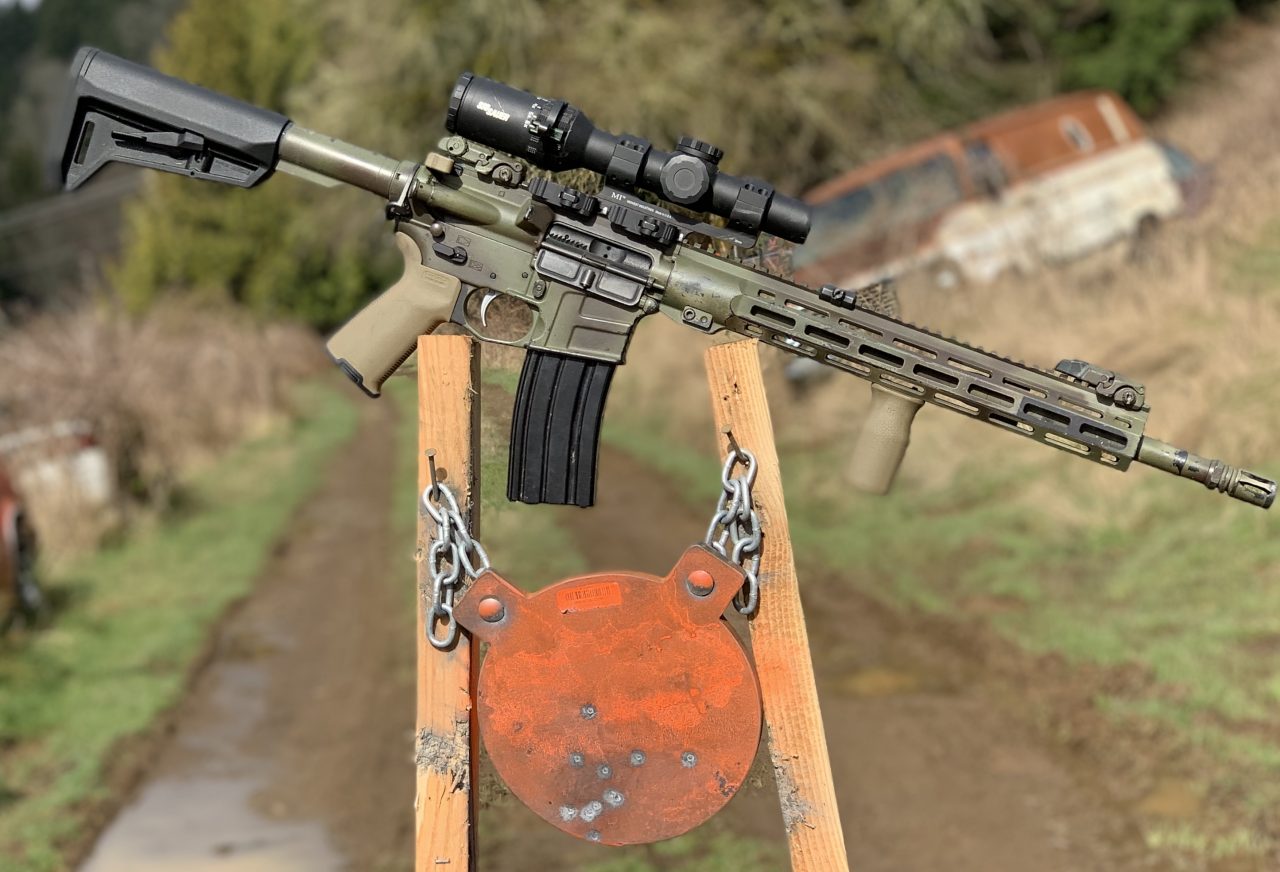
My Tango6T during the Midwest Industries scope mount repeatability test. Scuffed and dropped.
To test the durability a little more than the normal use of just being tossed and bumped, I dropped it a lot. After multiple drops and tosses, the BDC was still dead on at 287 yards. I know that isn’t very far for the scope, but in the conditions, I was in and the way my range is set up at the moment, my “control” target was that one. It is a 10” plate at 287 yards. If there was any noticeable shift at nearly 300 yards, I would have noticed if the scope was off. That target was easy to hit as long as I didn’t rush myself and pull the shot.
After the drop testing, I decided that wasn’t enough, so I mortared the rifle. I feel that mortaring the rifle is a good “real world” test for the stuck case that you can’t get out without some extra help. So after flattening out my shooting spot with the stock of my gun, I got back behind the scope and hitting the 10” plate at 287 yards was just boring. This is all on top of being tossed around during previous shooting trips. Riding in the back of a truck bed, being smashed around with other farm equipment, being smashed by other guns, and just general abuse that I expect my rifles to handle that I don’t even consider “abuse.” After all of that, the scope still worked as nothing happened.
Price and Value:
The Sig Tango6T retails for $1300-$1400, which is on the higher end of 1-6 variables for sure. However, I feel you are getting a scope PACKED with features at that price! First Focal plane BDC reticle out to 800 yards, 31 MRAD of turret adjustment, locking illumination with an off between every setting, long battery life, a lifetime warranty, and one extremely durable optic… just to name a few. The glass on this optic is extremely clear with no distortion on the edges, if there is any, I sure haven’t noticed it. The optic itself looks sexy sitting atop an AR, and we all know looks are the most important. We also have to include the cleaning pen and throw the lever in the value of this which I think are great things to have included. Taking ALL of that into consideration, the multitude of reticles Sig offers and having the Sig name and company backing this optic makes the price worth it in my opinion. This is a very competitive optic feature-wise for a shooter looking for a high-end LPVO.
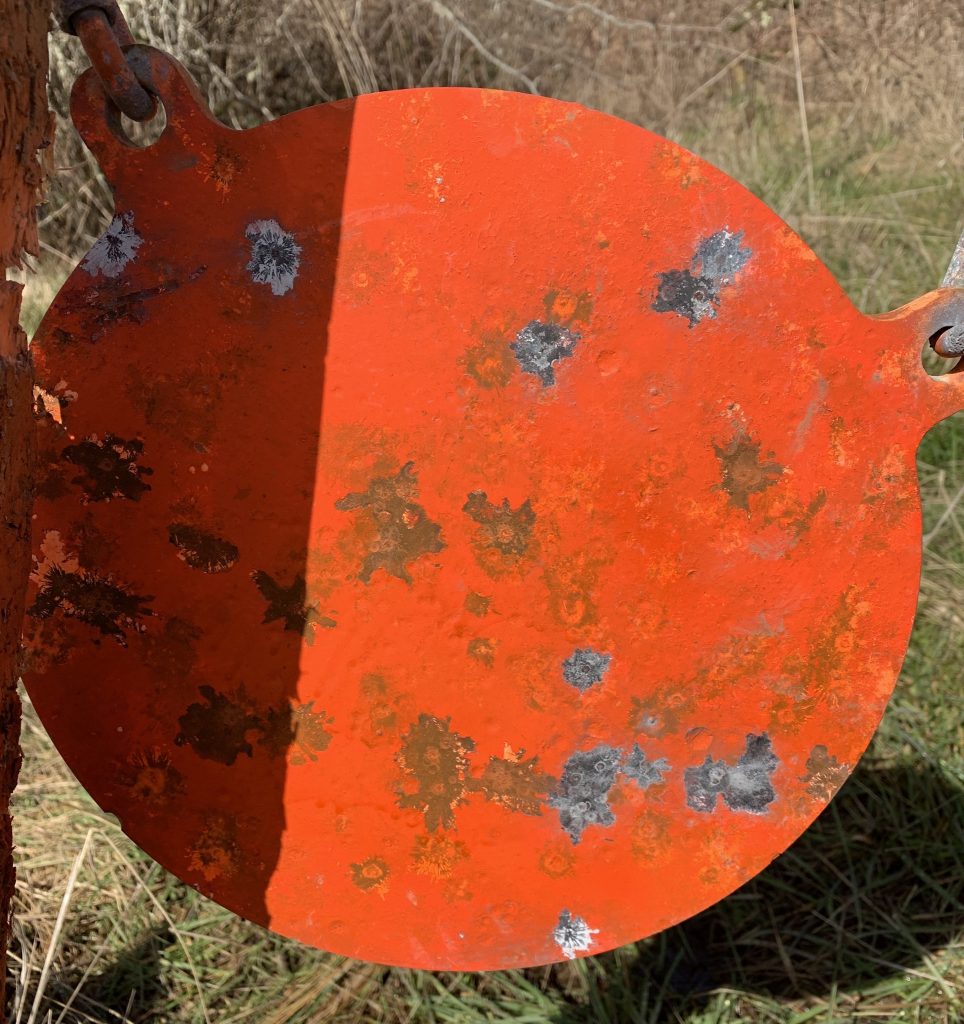
Tango6T on my Savage Recon at 450 yards! 12” plate. Shot roughly 25 rounds at this target. Once I figured out my hold with different ammo, I was hitting consistently!
Final Thoughts:
My personal opinion on this optic is it’s great! Like I said above, clear glass, LOTS of features, unconditional lifetime warranty. If you can afford it/ want to pay that much for an optic, I cannot recommend the TANGO6T enough. I have had zero problems with this scope which looks bad for the review because I feel like I’m being bribed to say this… which I’m not, but I have not had a single problem with this scope! What I have a small problem with is the manual of all things.
When I was reading the manual, everything made sense until I got to the reticles and zeroing instructions. The zeroing instructions were unclear as to what distance I need to zero my rifle at for the BDC to be accurate. I eventually found the zero distance not on the page detailing how to zero the scope, but on the reticle breakdown itself… and even then, it’s down in the corner. Furthermore, they don’t have an MRAD version of the 556/762 horseshoe dot reticle in the manual. I have been told that the reticle is, in fact, an MRAD reticle to match the turrets. When Sig designed the reticle, it was only in MOA scopes at the time and since it’s a BDC reticle, they just left the manual unchanged instead of adding another page to show the stadia line graduation in MRAD. So while the BDC is going to be very close for my 5.56 rifle, it won’t be exactly 300 yards or 500 yards, it might be 280 yards and 510 yards on my rifle and your mileage may vary. Will that make a difference in your shooting? It might, it might not, you just need to shoot and confirm for yourself. While it might not breakdown the reticle in MRAD as it does in MOA, it can still be defined with a chronograph and STRELOK or similar BDC calculator for your load and setup.
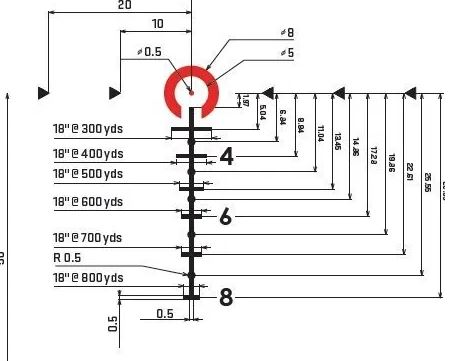
The manual shows the MOA version of the optic, whereas the MRAD version is missing. MOA example above
Am I nitpicking at this point? Yes, yes I am. However, nitpicking or not, if it matters to me, it may matter to someone else so I am including it in the review. Two very minor details. I am just OCD so it bothered me a little more than it should have.
If I had to pick people that are best suited for this optic, it’s for anyone who wants an optic that’s tough as nails, has plenty of practical features, and wants a tremendous lifetime warranty. This optic would be a great bet for people in military or law enforcement roles where you need a scope you can count on through anything. This scope is also a great fit for shooting competitors who want a scope that will always be zeroed after every barre dump, from competition to competition. It’s for prepared people that want an optic that will make it through the worst situations and be able to count on it when your life depends on it. However, would I recommend this scope for a casual shooter who shoots for fun, and shoots a handful of times a year? Yes and no. Yes, I will suggest this optic to anyone because its an amazing optic… But for the average recreational shooter, it may be overkill price-wise.
The bottom line, this is an excellent scope, made by a legendary company, at what I would consider a great price for the quality you are getting. Again, a VERY FEATURE RICH scope, backed by an amazing warranty. As the saying goes “buy once, cry once” but I’m pretty sure once you look through this scope, you will stop crying.
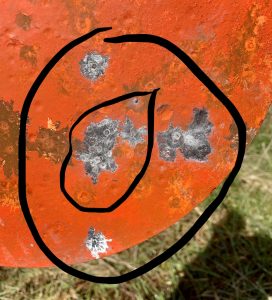
When I was testing the BDC on the Tango6T, this is one of the groups that I got at 450 yards. You guys are the judge, but the small circle is anywhere from a 4-6 shot group I think. And the big circle is roughly 4-13 shot group!
Other Notes:
Some other miscellaneous things that I noticed is that this scope didn’t fog up on me. While I was shooting and setting up my range, I was also shooting my AR pistol with a Trijicon MRO on it. I left my rifles at my shooting spot (unloaded and cleared) while I went and set up my target. While I was doing that, it rained and then got a little sunny. I do not know if the optic didn’t fog up because no rain got on the front of the scope due to the front glass being recessed into the scope body, or because I didn’t try to wipe the rain off it because I didn’t have to. But when I went to shoot my AR pistol, I could not see through the lens of my MRO. The Sig was clear.
Oops!
Before I posted this article, I sent a copy to Sig since they sponsored this article by sending me the scope to review. I wanted to make sure I got all of the information I give you guys right. Well, this whole time, I have been wrong about a detail and I need to apologize and correct myself. In the first article, I thought Sig equipped this optic with its motion-activated (MOTAC) technology. I was wrong. The battery life on this optic is just so good that I have left my optic on MANY times assuming it was equipped with MOTAC. This would have killed any other LPVO battery fairly quickly. Even though the battery life is only rated for 100 hours on the 5 or 6 setting, I have left the optic on the 9 setting for a couple of days and didn’t notice the optic get dimmer. Since I couldn’t tell that any battery had drained… I thought it had MOTAC technology. A win for Sig making the most out of the battery life!
If your interested in a SigSauer Tango6T, please consider purchasing one from Brownells, our site sponsor. Click Here!
Thenewrifleman LLC and the Author have no financial or advertising relationship with Sig Sauer – Sig Electro-Optics, and all opinions above are of the author and his experience with the SIG-Tango6T.





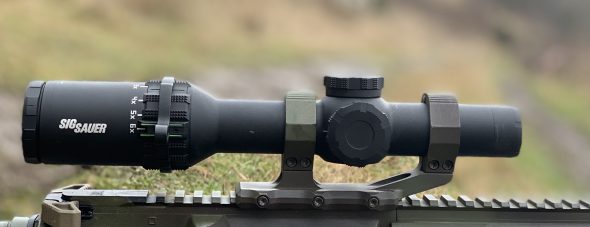



LPVO’s are great.
Thanks for the review.
D.S.,
I read your essay on the Tango 6T. What impressed was your use of the term “Daylight VISIBLE” rather than using the misnomer and deceptive term “Daylight BRIGHT” to describe the visibility of a lighted reticle. Few optics are “Daylight Bright”. This term, created by the optics industry, is just the manipulation of words and definitions to enhance their product description. In turn, to sell more product.
I have advocated for the honest use of describing a lighted reticle “visible” rather when, in fact, being “bright” is the furthest thing from the truth. “Daylight Bright” is nothing more than Newspeak. Thank you for your honest description.
Words have meaning Citizens !
ERWACHE
I’m glad you appreciate that. It was so close to being daylight bright, but in just the wrong conditions with the sun reflecting off the target, it got washed out. Still a very bright reticle and I highly recommend this optic!
I recently picked one of these up as well and I’m held up on the zeroing information, too. I found the manual with the subtension data in MOA (which is fine as mine scope is MOA), but the zero distance isn’t listed anywhere. The only information listed about the BDC are the obvious stadia line measurement for each given distance. What distance did you zero yours at? I’m assuming 50, as most LPVOs with BDC use this, but considering the lack of information I’m not sure. The only other distance I would consider is 100 as the 300 stadia has its own horizontal stadia line instead of being the tip of the post like on other optics, making the tip equate to 200.
Thanks
If you look on the page of the reticle details, it should say. I have the 556 horseshoe dot and in the bottom left corner all it says is 100 yard zero.
Can you share which mounts you started out with before changing over to the Midwest Industries QD? I just purchased this LPVO but would like to find a good set of mounts for it. I have never owned an LPVO so I am a little outside of my comfort zone in looking for mounts for one to go on my AR to replace the Sig Romeo5.
I used the aero precision lightweight mount. It’s a solid mount but as much as I recommend it, I recommend any fixed mount for a rifle specifically for target shooting or a varmint rifle. Having a scope, especially a 1-6 scope, indicates that this is a do everything rifle for you. I would recommend a QD Mount for that in case your scope fails when you really need it moment. In a few seconds you can remove your scope and have your irons.
Thanks for the update. I plan on using an offset (aka canted) mount for BUI’s and an MRD/RDS in case the LPVO fails. I am working on a few prototypes as well for those canted sight mounts so I might just have to see about making my own scope mounts if I can’t find the Aero’s, Giessele or MI QD anywhere. Everyone I can find is saying they are between 2 – 8 months from delivery of the various scope mounts.
Sadly, Sig has discontinued their Tango6T series in Black. I’m pretty disappointed by this, as I’m not an FDE kind of guy. I’m very happy with my FFP 5.56 Horseshoe Reticle. I use a Badger Ordinance Condition One 30mm 1.70 mount. It’s a solid one piece mount which allows you to attach an Aimpoint T2 at a 45 degree for closer shots.
I saw that. I wish the has their blacks scopes still. I do like the FDE though. I really wish they still had their regular Tango6 line. They discontinued that right before I was able to get my hands on one.
D.S. I have access to a few different TANGO6 optics. Feel free to drop a message to me somehow for pricing on the various reticles and powers. Just to make sure you are talking about the TANGO6 3-18X44 mm, TANGO6 5-30×56 mm????
Thanks will! I appreciate it! I’m talking about the Tango6 1-6 they had. It was their budget friendly 1-6 line. I got my hands on their 6T with the intent to do a comparison to the Tango6 later. However when I contacted Sig I was a little too late
When I look at Sig’s website and primary arms, it says this optic does have MOTAC. But in this article at the end you mention that it doesn’t. What’s the correct info? Did sig say it does not have MOTAC when the product page on their site says it does?
That’s exactly it. Sig themselves told me that it does not have MOTAC. Even though every website says it does.
Can confirm that it does not have MOTAC.
Sig, primary arms, opticsplanet, etc all say this optic has motac
It does say it has MOTAC and I thought it did too at first, however it doesn’t. Even Sig’s website looks like it says it has MOTAC.
I’ll have the same setup. Just realized my reticle is the DWLR6 so it’s not technically for a .556 gun but the guy who I bought it from said it doesn’t matter that much. Should I get the horseshoe reticle instead intended for .556?